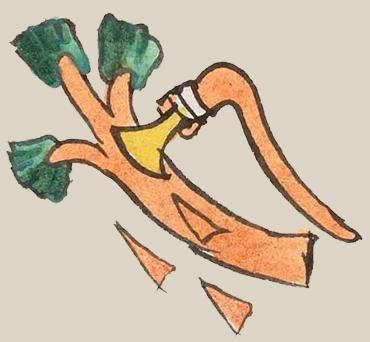xima (Mdz5v)
This element for the verb to plane or shave wood (xima) has been carved from the compound sign for the place name, Cuauhximalpan. It shows the trunk of a tree, with a leader and two branches. An ax or hatchet is chipping wood from the trunk. The wood is a terracotta color. The branches have two-tone greenery. The hatchet has a wooden handle, and the blade is tied onto it, probably with a white leather thong or string. The blade is yellow.
Stephanie Wood
For comparison, see the man chopping a tree down and removing branches in the Florentine Codex, Book I, folio 26 recto. Gordon Whittaker suggests that the perfect tense of xima (xin) is used when combining.
Stephanie Wood
c. 1541, but by 1553 at the latest
Stephanie Wood
cutting, planing, chipping, cortando, tallar madera

xima, to shave, plane, or cut wood, https://nahuatl.wired-humanities.org/content/xima
to plane, cut, or shave
XIM(A)
tallar madera
Stephanie Wood
Codex Mendoza, folio 5 verso, https://digital.bodleian.ox.ac.uk/objects/2fea788e-2aa2-4f08-b6d9-648c00..., image 21 of 188.
The Bodleian Libraries, University of Oxford, hold the original manuscript, the MS. Arch. Selden. A. 1. This image is published here under the UK Creative Commons, “Attribution-NonCommercial-ShareAlike 3.0 License” (CC-BY-NC-SA 3.0).


